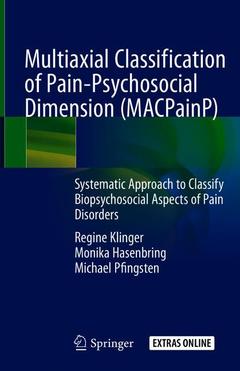Description
MACPainP Multiaxial Classification of Pain Psychosocial Dimension, 1st ed. 2019
Systematic Approach to Classify Biopsychosocial Aspects of Pain Disorders
Authors: Klinger Regine, Hasenbring Monika, Pfingsten Michael
Language: English
Subjects for MACPainP Multiaxial Classification of Pain Psychosocial...:
105.49 €
In Print (Delivery period: 15 days).
Add to cart118 p. · 15.5x23.5 cm · Hardback
Description
/li>Contents
/li>Biography
/li>Comment
/li>
This book offers a diagnostic tool for physicians and psychologists who want to systematically document pain within a multimodal structure. MACPainP (multiaxial classification of pain-psychosocial dimension) is a systematic, comprehensive and clinically oriented diagnostic instrument for evaluating pain-related disorders, and includes differentiated descriptions to enable syndromes to be systematized and diagnoses compared. MACPainP can be used as a professional add-on for the International Classification of Diseases ICD-10 as well as the upcoming pain classification ICD-11, released by WHO.
This clearly structured book provides an easy introduction to the biopsychological aspects of pain disorders, to allow a nuanced approach to the psychological diagnosis of pain patients. It discusses possible comorbidities (e.g. depressive disorders, anxiety disorders) as well as concrete behavior-related steps for pain-related psychological and medical treatments. An essential reference for physicians and psychologists in the field of pain therapy, it is part of the learning European Pain Federation Curriculum (EFIC) of pain therapists.Introduction.- Description and Evaluation of Approaches to the Classification of Chronic Pain.- The Possibilities for Classification within the Internationally Accepted Diagnosis Key ICD (see also DSM for Chapter V (F)).- IASP-Taxonomy.- Headache Classification of the HIS.- The Multiaxial Pain Classification MASK of the DGSS.- The Multiaxial Pain Classification - Somatic Dimension (MASK-S).- The Multiaxial Pain Classification – Psychosocial Dimension (MASK-P).-The Multiaxial Pain Classification – Psychosocial Dimension.- (MASK-P): Theoretical Background, General Guidelines and Operationalization of the Axse.- Theoretical Background.- The Behavioural Theory Basis.- Depth Psychology Basis.- System Theoretical Basis.- General Guidelines.- Restrictions of the MASK-P - Codes Relating to Psychopathological Disorders as classified by ICD / DSM.- Operationalization and the Awarding of Codes.- Axis Supplementary code.- Time Supplementary Code MASK-P- Rating Form Diagnostic Axis 11: MASK-P-Diagnoses.- MASK-P - Diagnosis- and Rating Form.- Training Implications.- Deriving the Therapeutic Indications.- Combining with ICD and DSM / Examples of Applications.- MASK-P – Operationalisations.- Motor Behavioural Strategies for Coping with Pain.- Emotional Coping Strategies for Pain.- Cognitive Coping Strategies for Pain.- Illness Related Metacognition.- Current Stressors.- Trauma / Stress in Life-History.- Habitual Personal Features.- Maladaptive Coping Strategies.-Psychophysiological Dysregulation.- Coping Styles for Conflict.- MASK-P - Diagnosen: Functional Connections.- Literature List.- Tables.
Regine Klinger (PhD) is responsible for the Department Pain Psychology at the Clinic and Outpatient Clinic for Anesthesiology at the University Medical Center Hamburg-Eppendorf (UKE). Until December 2016 she was the president of the German Society for Psychological Pain Therapy and Research (DGPSF), the vice president of the German Pain Society (Deutschen Schmerzgesellschaft e.V.), and vice-president and member of the advisory board of the German chapter of the International Association for the Study of Pain (IASP). Her main areas of research are psychological pain management in headache and back pain, placebos and nocebos, learning processes in the development and maintenance of chronic pain, and pain classifications.
Dr. Monika Hasenbring is a professor of Medical Psychology and director of the Dept. of Medical Psychology and Sociology at the Ruhr-University of Bochum, Germany. Her primary research interests are psychobiological models, risk factors and mechanisms in the transition from acute to chronic pain. Her research comprises experimental and clinical work including the development of questionnaires assessing different features of psychological pain processing. This research has been funded for several years by the German Federal Ministry of Education and Research (BMBF), the German Research Foundation (DFG), the EU and within a nationwide German Institute of Sports Medicine (BISP) research network. Dr. Hasenbring is a member of the German Committee for the National Guidelines of Diagnostics and Treatment of Back Pain (NVL Back Pain) and co-editor of “Der Schmerz” (“Pain”; the official journal of the German Chapter of IASP: German Pain Society (Deutschen Schmerzgesellschaft e.V.)Prof. Michael Pfingsten is a professor of Medical Psychology and head psychologist at the Department of Pain Medicine at the University Medical Center Göttingen (UMG) Clinic of Anesthesiology. In 2008 he was temporary head of the Department of Medical Psycholo
These books may interest you

PainPsychological Perspectives 64.97 €


